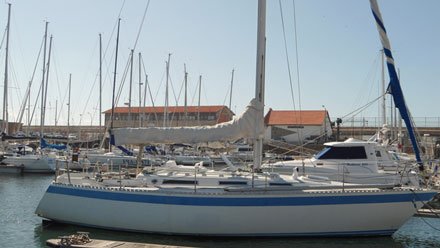Although this IOR-influenced design may appear a little dated, the Pretorien 35 is a go-anywhere design that offers excellent value and a quality of construction that rivals that of some of the finest production boats in the world.
The low profile, wedge-shaped trunk cabin often causes this design to be confused with Sweden Yachts and Swans of the same era, but she was built by Chantier Henri Wauquiez (pronounced “Vo-key-ay”) of Mouvaux, France and designed by the noted UK firm of Holman and Pye. The model was introduced in 1979 and continued in production until 1986.
The quality of construction of the Pretorien 35 is about as good as it gets for production boats; although, she was built in the days before vinylester resins were commonly used, and osmotic blistering is common below the waterline. Generally, I’m not an advocate for radical blister repair of aging boats. Quality blister repairs are expensive, add only marginally to a boat’s value, and undermine added longevity. Most people don’t keep older boats long enough to amortize or justify the cost of these repairs. That said, the quality and value of the Pretorien 35 make her an ideal candidate for a quality repair, particularly if the owner expects to keep the boat for five or more years.
Many of the construction features, such as the six longitudinal stiffeners that run the entire length of the hull and the unique method of bulkhead attachment, are not readily apparent to the casual observer. But, you need to look no further than inside lockers to see the care the builder has taken to create a remarkably smooth, exceptional quality finish.
The hulls were constructed of a solid laminate of hand-laid fiberglass and resin with balsa wood core used to stiffen and reinforce the deck structure. The builder took care to eliminate the balsa core where hardware and fittings are attached. Teak deck overlays were offered as an option. All are now over 20 years old and likely in need of major repairs, removal, or replacement.
The IOR-influenced narrow transom of this design creates a small cockpit which is about six feet long and only 54 inches wide between the bases of the seatbacks. Pedestal-mounted wheel steering was standard and takes up cockpit space. Although small, the cockpit has a seat-level bridgedeck forward and a very substantial welded, stainless steel stern rail and is ideal for offshore passages. Side decks are wide with rigging shrouds and genoa tracks set well inboard to allow for easy passage. A foredeck anchor locker provides plenty of room for stowage of a suitably sized anchor and sufficient rode. One of the unique features of the deck arrangement, and another example of the builder’s attention to detail, are the molded mounting pads for winches with matching pads for cleats angled so that lines are led fair from the winch.
The interior arrangement features a V-berth cabin forward followed by starboard head and port hanging lockers. In the main saloon, there is a U-shaped dinette to starboard and 60-inch-long settee to port. The navigation station is aft of the settee, and the galley is opposite to starboard. A classy addition, and Wauquiez trademark of the era, is the ceramic tile galley counter. There is a quarter berth cabin to port suitable for two children or small adults. Joiner work is excellent throughout, and storage is quite good. Three deck hatches, two solar vents, and two dorade vents provide only marginal ventilation for the cabin spaces.
Auxiliary power is provided by a Volvo diesel beneath the companionway steps. Most models are equipped with Volvo saildrives, although conventional shaft and propeller arrangements are installed on some models. If you think I’ve been gushing a bit too much about this boat, let me tell you what I think of engine access—it stinks. Saildrive units are particularly prone to damage from galvanic or stray current, so they must be continually monitored. If any corrosion of the aluminum gear housing is noted, have someone thoroughly familiar with corrosion and marine electrical systems investigate immediately.
The Pretorien 35 has a modest sail/area displacement ratio of only 15.6, a high aspect mainsail, and large masthead genoas typical of early 1980s vintage IOR designs. In wind speeds of less than six to eight knots, boat speed is not impressive, but as wind speed picks up, performance improves. Ballast is 46 percent of displacement, and the range of positive righting moment is quite good. The Pretorien 35 has a large rudder with a deep skeg forward. By all reports, she does not share the nasty down-wind habits typically associated with IOR designs.
All the rigging shrouds of the double-spreader, masthead rig are led to single-point chain plates necessitating a baby stay to shape the mainsail and prevent the mast from pumping in windy conditions.
Of the more than 170 Pretorien 35s built, a fair number have found their way to our shores. Currently, www.yachtworld.com lists six East Coast boats for sale, ranging in price from $66,500 for a 1984 model in North Carolina to $97,000 for a 1983 model in Annapolis. The average selling price of four East Coast models sold over the last year was $66,125.
If you’re yearning for a very high quality boat but find most far out of your budget, this is a model worth taking a look at. Even though systems, sails, and finishes may be over 20 years old, mid-1980s models can be purchased and substantially refit for less than $100,000. This can’t be said of very many comparable quality boats.
Specifications:
LOA 35’ 1”
LWL 30’ 4“
Beam 11’ 7”
Displacement 13,000 lbs
Draft 6’
Reviewed in the February 2008 issue of SpinSheet by Jack Hornor





